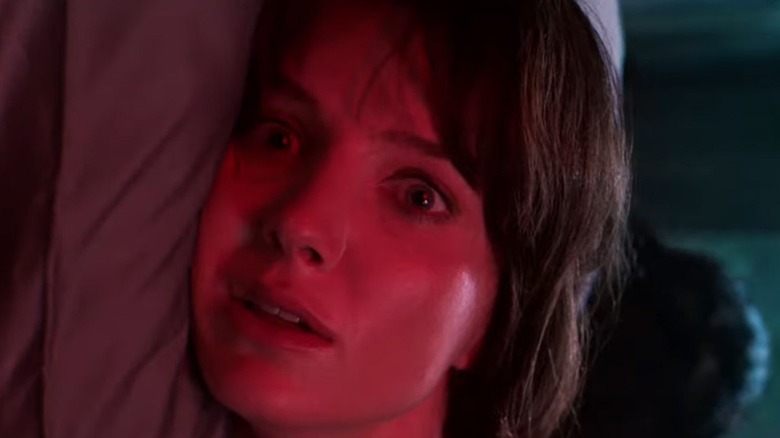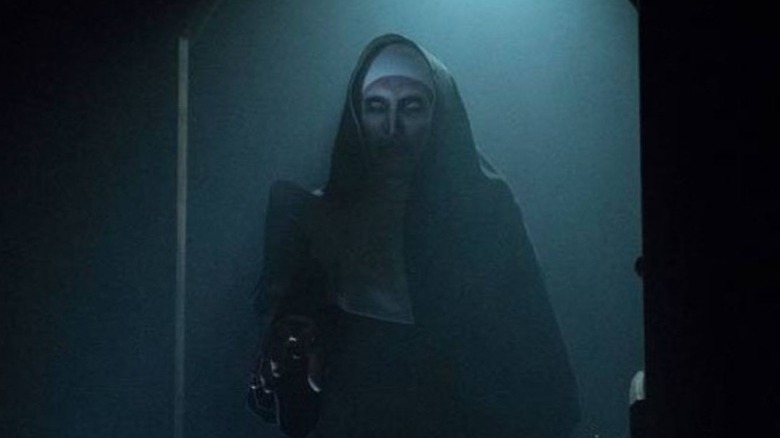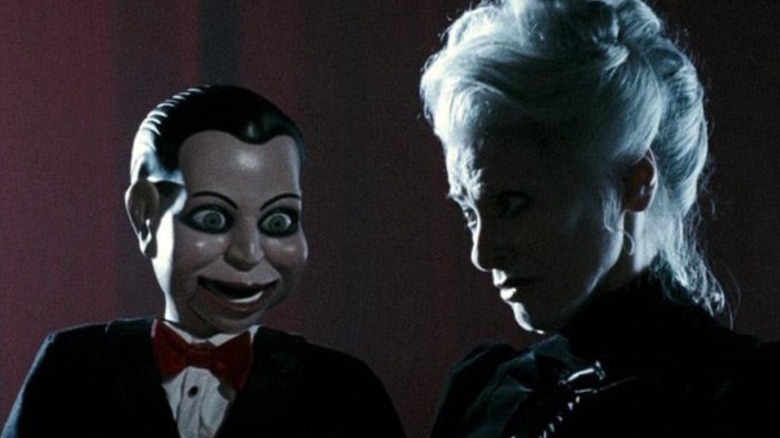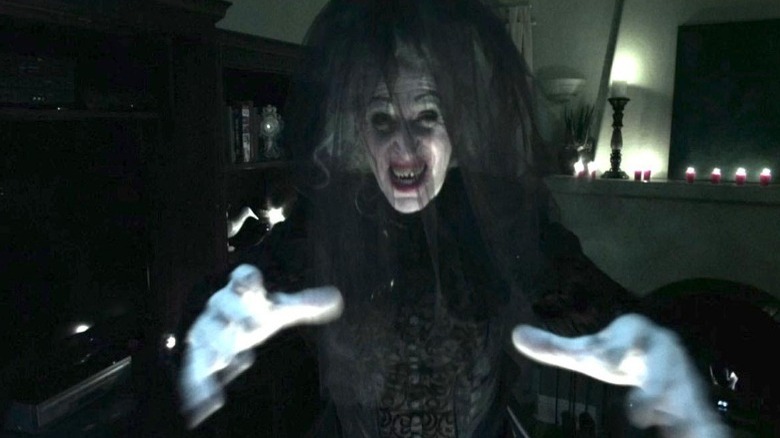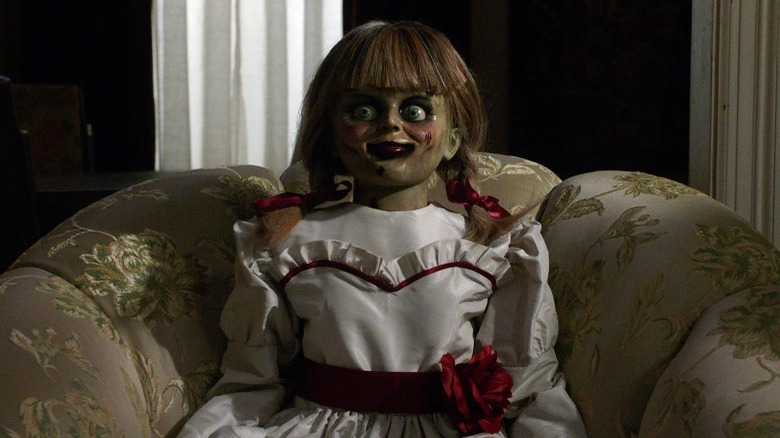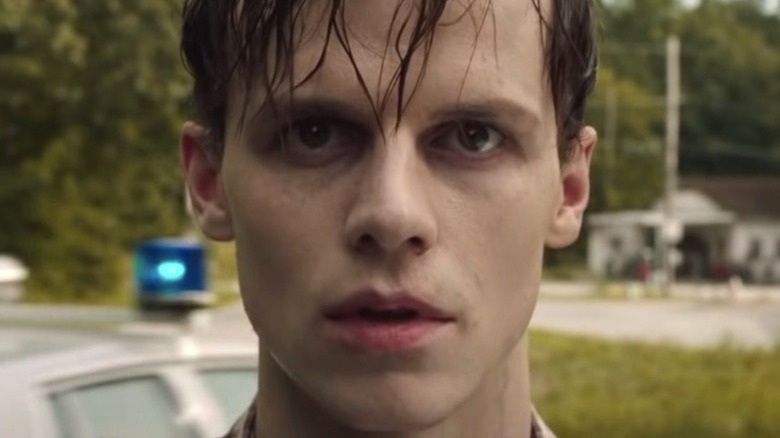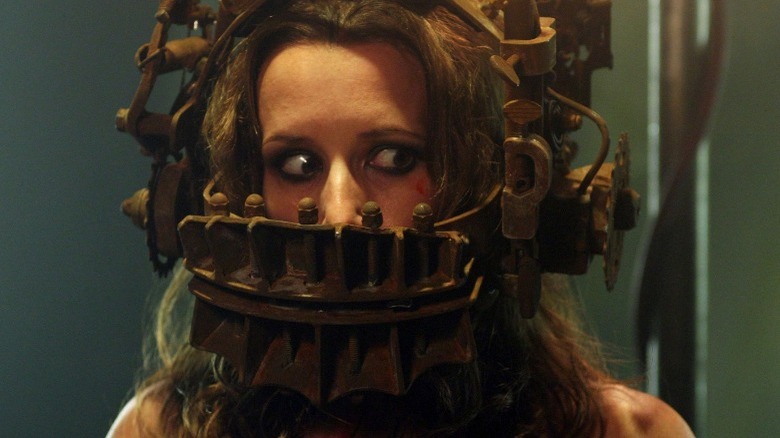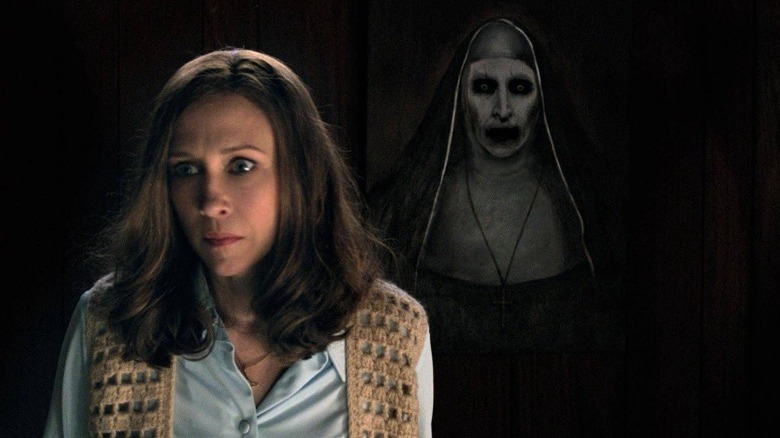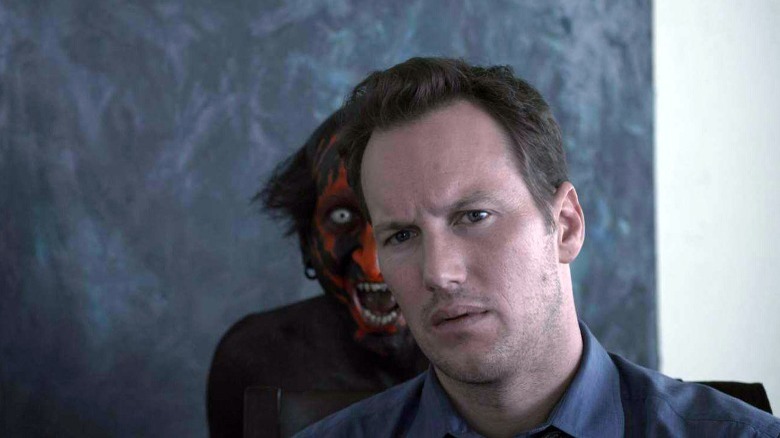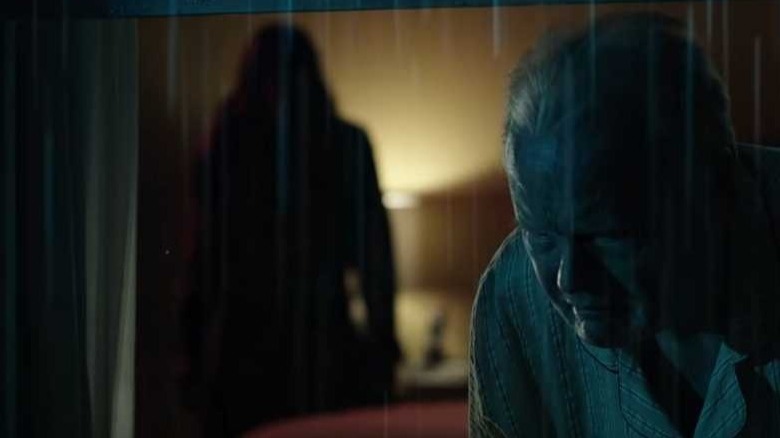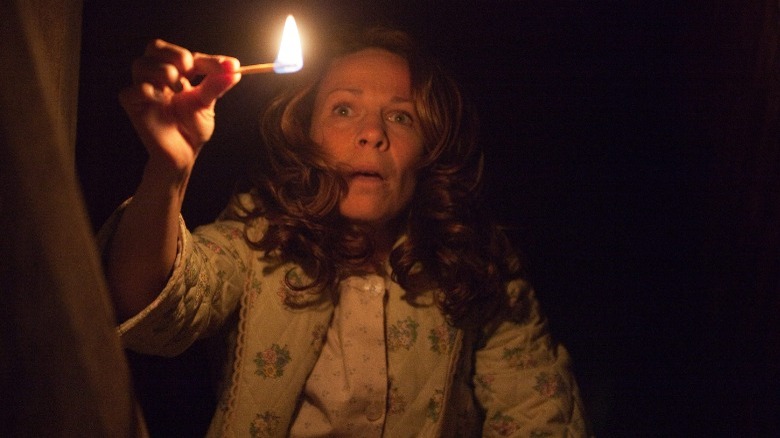James Wan's Horror Movies Ranked Worst To Best
For years, names like John Carpenter and Wes Craven have been synonymous with the horror genre in cinema. It's safe to say that writer/director James Wan has carved out a sizable space for himself in the halls of horror legends, joining those aforementioned icons. In just the past two decades, he has shocked and terrified audiences through jump scares, disturbing imagery, and eerie tales that will make the hair on your neck stand on end.
Wan has mastered the ability to produce quality horror films that are highly profitable, thanks to keeping production budgets low and expectations high. He puts most of the film's value in the narrative, and its ability to cultivate anxiety and anticipation. Furthermore, the way he toys with the elements of mystery creates a solid, unmooring hook for audiences. While Wan has dabbled in big blockbuster affairs with films like "Furious 7" and "Aquaman," he consistently returns to the realm of horror, where he got his start and has proven time and again it's where he belongs.
With that said, let's take a look at James Wan's horror films, ranked from worst to best. Beware, spoilers ahead.
10. The Nun (Writer)
The terrifying villain of "The Conjuring 2" secured a film with an origin story in this tale from the "Conjuring" universe. "The Nun" is just the film to do the job — sort of.
The setting takes viewers back to the 1950s, in the heart of Romania. In a remote abbey, two nuns are terrorized and destroyed by a demonic force. The church sends Father Burke (Demian Bichir) and Sister Irene (Taissa Farmiga) to investigate. They learn that during the Middle Ages, the abbey was originally constructed as a castle for a duke that was knee-deep in the occult. The duke unleashed the demon Valak (Bonnie Aarons) through a rift within the castle. Ultimately, he was killed by crusading knights and the rift was sealed. However, bombings during World War II fractured the sealed rift, opening it once again for the demon to escape.
The duo seemingly succeeds in repelling the evil force within the Abbey. However, Frenchie (Jonas Bloquet), a local villager who aids in the fight, is quietly possessed by Valak as indicated by an upside-down cross mark in the closing moments of the film. This ties into "The Conjuring" where Ed (Patrick Wilson) and Lorraine Warren (Vera Farmiga) would later present footage of his exorcism at a university seminar.
Unfortunately, "The Nun" leaned heavy on shock value and jump scares, and didn't place as much stock in its overarching narrative, leaving some noticeable gaps without ever fully earning its resolution. "The Nun" wasn't a critical darling by any stretch, earning a measly 24% from critics on Rotten Tomatoes.
9. Dead Silence (Director, Writer)
There are few things creepier than the cold stare of a classic, pale ventriloquist dummy. "Dead Silence" uses that creep factor to great effect.
The story follows Jamie Ashen (Ryan Kwanten), a recent widower after his wife dies of mysterious circumstances at the beginning of the film. The couple had just received an anonymous gift — a ventriloquist doll by the name of Billy — and Jamie is initially suspected of murdering his wife. However, due to inconclusive evidence, Detective Jim Lipton (Donnie Wahlberg) releases him from custody. Jamie then embarks on a quest for answers in hopes of solving the mystery of his wife's untimely demise. He learns that Billy was a doll that belonged to Mary Shaw (Judith Roberts) — a former ventriloquist. Years ago, during one of her shows, a boy by the name of Michael criticized Mary during one of her shows claiming that he could see her mouth moving. Some time later, the boy disappeared and Mary was accused of being the culprit. The family took justice into their own hands, murdering her, but not before forcing her to scream so they could cut out her tongue.
Now, Mary Shaw is haunting the bloodline of Michael, taking revenge in the same manner. Should a potential victim scream, they are killed and their tongue is removed. The film is quite unique in its tale and managed to capture an unsettling, eerie tone throughout. While the dolls never came to life, their blank, expressionless stares haunted the screen. "Dead Silence" is a terrifying tale with a dark twist in the film's final moments that ensures viewers won't soon forget Mary Shaw.
8. Insidious: Chapter 2 (Director, Writer)
"Insidious: Chapter 2" picks up where the first film left off. Josh Lambert (Patrick Wilson) had been possessed by a ghastly woman's spirit in the further when trying to retrieve his son from the spiritual plane. It was revealed that this spirit had stalked Josh his entire life.
While possessed, he killed Elise Rainier (Lin Shaye), the demonologist who was aiding the family in retrieving their son. In the sequel, Josh is suspected of Elise's murder. Additionally, he is deteriorating, much to the suspicion of his wife and family. Eventually the family discovers that the spirit is actually a man by the name of Parker Crane (Tom Fitzpatrick) who, in life, would stalk and murder other women while dressed as a woman himself. He was known as "the Bride in Black." Now, like many of the spirits in the spiritual realm of "the further," he desires to have a body once again.
The film carefully wove its narrative around the events of the first film. While in the further, time isn't linear, and Josh is able to revisit past moments when he was a child, as well as scenes the audience will recognize within the first film. The tie-ins to the original movie were clever, and the narrative respected the audience enough to not consistently retread familiar ground. The continuation of the first film's story worked well, offering a proper conclusion to the Lambert family's struggles with the supernatural.
7. Annabelle Comes Home (Writer)
"The Conjuring" briefly introduced the world to the horrific doll Annabelle. At the time, none of us had any idea that the doll would eventually acquire her own trilogy of films.
"Annabelle Comes Home" is the third film centered around the doll, although its narrative isn't tied to the other two films. With James Wan's involvement in this production, it comes as no surprise that "Annabelle Comes Home" is tethered to the early moments of "The Conjuring," when Ed and Lorraine Warren first obtained the doll. "Annabelle Comes Home" shifted a bit from the demonic hauntings that audiences witnessed in the first two films, instead making the doll a catalyst for other spirits to act freely.
With the Warrens going out of town, they bring Mary Ellen (Madison Iseman) over to babysit their daughter Judy (Mckenna Grace) overnight. Mary's friend Daniela (Katie Sarife) then comes over, and curiosity leads her to unlock the protective case that conceals Annabelle's power and influence. Soon after, Annabelle frees other spirits within the Warren's artifact room. A haunting bride, the Ferryman, and even a ghostly werewolf figure known as the Black Shuck all take time to terrify the three girls. "Annabelle Comes Home" wasn't simply more of the same. The filmmakers gave audiences additional creepy icons within this horror universe to sink their teeth into, beyond the titular demon-possessed doll. Who knows? Perhaps a few of them could get their own Wan film one day.
6. The Conjuring 3: The Devil Made Me Do It (Writer)
While this is the only "Conjuring" film Wan didn't direct, he did write, produce and exert a significant influence over the final product. "The Conjuring 3" set out to pioneer new territory, telling the real-life murder trial of Arne Cheyenne Johnson in 1981 — who claimed as a defense that demonic possession caused him to commit the act. Although initially skeptical, the Warrens investigate the claim in the event Arne (Ruairi O'Connor) is telling the truth.
"The Conjuring 3" sacrifices some of the franchise's terror in order to offer a mystery narrative. While the movie certainly has jump scares and shocking moments, it never quite reaches the horror-heights of its predecessors. However, the story offers a fresh experience in the "Conjuring" universe that brings audiences along for a supernatural murder investigation, hunting for cursed totems and demonic cults. Fans of the series and characters will still enjoy the film for the expansion in lore that it brings to the series. However, it's hard to imagine anyone preferring it over its predecessors, primarily because it fails to deliver the franchise's trademark scares.
5. 5. Saw (Director, Writer)
James Wan's career launched in 2004, when the Australian-born filmmaker made a short with friend/filmmaker Leigh Whannell called "Saw," which they sent around to studios in an attempt to pitch a horror script. Soon enough, Wan was hard at work on his low-budget theatrical directorial debut, and the 2004 feature-length "Saw" would become a phenomenon.
Estimated to have brought in more than $100 million over its modest budget, the grisly film attracted horror fans far and wide, christening an unfortunately-nicknamed new genre ("torture porn"), as well as a litany of sequels. While Wan had peripheral involvement with the subsequent films, the original "Saw" is the only one that featured him in the director's chair.
The beauty of the first film was its raw minimalism and originality, increasingly diluted by rehashed sequels. The original "Saw" largely took place in a derelict bathroom, with two individuals chained to opposite sides of the room. They came to learn that they were playing a twisted game in which they must experience pain in some capacity in order to survive and be released. The mastermind Jigsaw (Tobin Bell) was revealed to be a man who'd been diagnosed with a terminal illness and was acting out a sort of vengeance on those who he identified as taking life's blessings for granted. In his view, Jigsaw is helping these people learn to be grateful for what they have. If they can't learn this lesson, they will perish — importantly, as the result of their own choices and actions.
The movie took its audience through a winding narrative, filled with out-of-left-field revelations, shocks, and bloody carnage until the final scene when the entire scope of Jigsaw's plan was revealed. While the film featured such names as Cary Elwes and Monica Potter, make no mistake — the real star was the traps, sadistic, messy and unfailingly squirm-inducing.
"Saw" doesn't go lightly on the gore, giving audiences many opportunities to cringe and wince at the torment of those on screen. At the center of the film's narrative is a profound message by its antagonist to appreciate life — nonetheless, it's as far from a "feel good" movie as you can get.
4. The Conjuring 2 (Director, Writer)
If anything is seared into our minds from the horror franchise that James Wan started, it's that horrific painting of the demon nun, Valak.
"The Conjuring 2" took audiences to the Enfield haunting in London. As a precursor to those events, Ed and Lorraine Warren are seen investigating the famous Amityville murders that inspired books, horror films, and documentaries. It is here that Lorraine has a premonition of Valak and her husband's future death at its hands. Fast forward a year, and the Warrens are helping the Hodgson family determine what is causing eerie occurrences within the home. Initially, the home is seemingly haunted by a prior owner, Bill Wilkins (Bob Adrian), who vehemently asserts that it is his home.
Eventually, it is discovered that the demon Valak is manipulating the spirit of Bill Wilkins and is possessing young Janet Hodgson (Madison Wolfe). The Warrens make a stand against the terrifying spirit, and from there things just go off the rails.
"The Conjuring 2" sparked fear through disturbing sequences and imagery that terrified audiences. The demon Nun, in particular, cast a chilling effect over audiences, so much so that she received her own aforementioned feature film. But although "The Conjuring 2" earned its horror stripes, it didn't do enough to separate itself from the simplicity and originality of first film in the series.
3. Insidious (Director, Writer)
"Insidious" presented the idea that a home or space is not the only thing that can be haunted. In fact, it showed us what it would be like if a person was haunted.
Dalton (Ty Simpkins), the son of Josh (Patrick Wilson) and Renai Lambert (Rose Byrne), is the ostensible central character in "Insidious," and begins the film by slipping into a coma for no apparent reason. The parents, determined to help their son, do everything they can to seek treatment, but nothing works. Eventually, they notice frightening figures stalking the halls of their home. After consulting a demonologist, Elise Rainier, she explains that Dalton has the ability to astral project his spirit into a spiritual plane that Elise calls "the further." He manages to do this involuntarily during his dream states, thinking he is dreaming. But now he is trapped in "the further," and other spirits are gathering around his body in hopes of taking it for themselves.
As luck would have it, Dalton's abilities are no coincidence. Elise explains that Josh can also do this, leading to a suspicion it might be hereditary. As a young child, Josh was relentlessly stalked by a ghastly spirit, and he eventually suppressed his memories of the events, including his ability to astral project. Elise explains to Josh that it is up to him to go into "the further" and retrieve his son.
The experience is harrowing, filled with scares and delights in the spiritual plane. "Insidious" was praised for its originality and attracted a significant following among horror fans. Much like Wan's other horror efforts, the 2011 film's relatively low budget also made it highly profitable.
2. Malignant (Director, Writer)
James Wan is a master of horror. But by most accounts (with the exception of "Saw"), his talents have been relegated to a certain type of supernatural horror. "Malignant" changed all of that. Early in the film, it's easy to assume that a malevolent spirit is at the heart of spooky murders that are occurring within the life of Madison Lake (Annabelle Wallis), a seemingly ordinary woman in an abusive relationship. After her husband physically assaults her, everything in her life is turned upside down. An unknown individual by the name of Gabriel kills her husband, before systematically murdering medical professionals involved with psychiatric research.
Madison witnesses these murders within her mind, unsure how she able to see them occurring. She is revealed to have been adopted. After Madison's adoptive sister and mother go down the rabbit hole of her past, they uncover a terrifying reality regarding both Madison and Gabriel. What follows in the third act of the film is a wild shift from horror mystery, to an over-the-top slasher fest of the creature-feature variety. The film is truly a roller-coaster ride and worth the attention of horror fans. "Malignant" is a markedly different style of horror than any of James Wan's previous titles. For that reason alone, it has a split reception from audiences: Shortly after opening, Rotten Tomatoes listed the film at 77% fresh reviews among critics, with a 51% audience score.
1. The Conjuring (Director, Writer)
Even in this age of cinematic universes, few expected that the "The Conjuring" would hold the origins of a sprawling horror franchise of its own. However, the now-classic flick has led to several films, including 2 direct sequels and 5 spin-offs.
Without the initial breakthrough and blueprint of "The Conjuring," none of it would have been possible. The original film introduced audiences to Ed and Lorraine Warren has they helped the Perron family rid their home and lives of a demonic force. While that basis may at first feel like well-tread-upon ground, it was Wan's creative, almost-throwback thrills that catapulted the film to the top of the ranks among modern horror. Simple, ghostly hand claps, playing with the lighting and offbeat camera angles came together in a way that stoked tension and fear, and looking back today you can see how such disparate elements were masterfully orchestrated for maximum terror.
"The Conjuring" even initiated a trend for its direct sequels, one that featured actual accounts of the real-life Warrens' investigations as a basis for the films. Of course, there's no need to be afraid: the incidents depicted in Wan movies like "The Conjuring" have been embellished and dramatized for effect — or have they?
